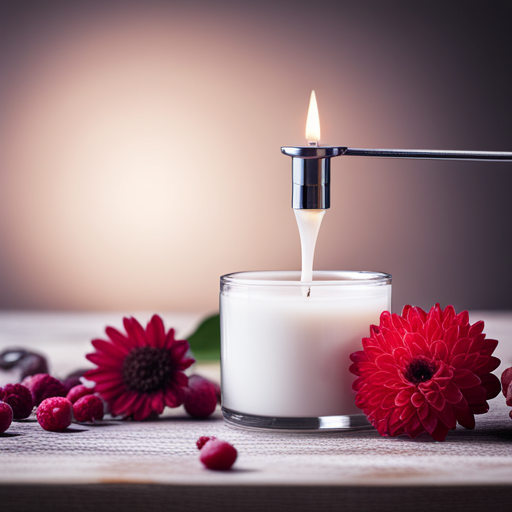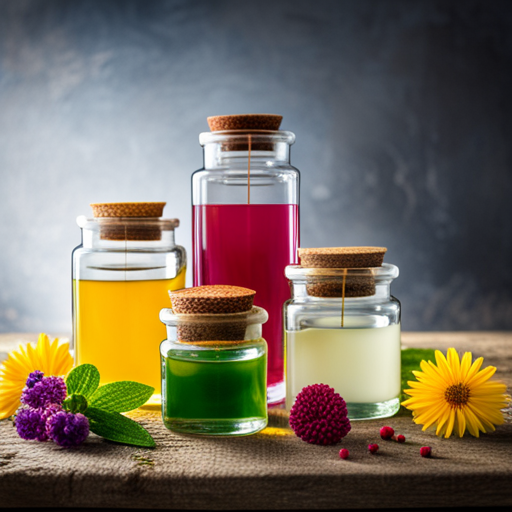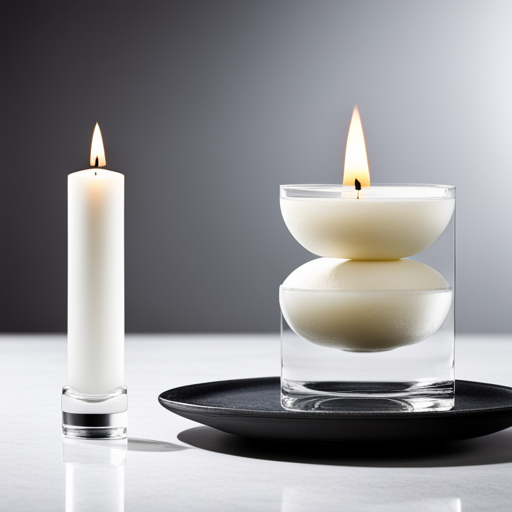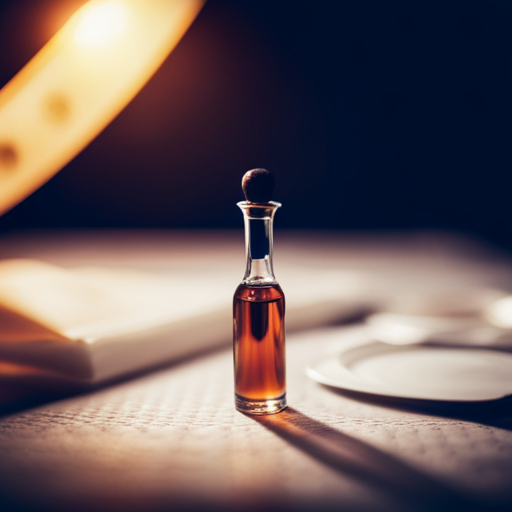The article will also explore factors that affect fragrance oil usage in different types of wax and provide tips for achieving the perfect scent strength in candles.
Beginners will find essential candle-making tips to ensure safety and quality.
Key Takeaways
– There are several methods for adding fragrance to candles, including adding fragrance oil directly to melted wax, adding essential oils to the wick before dipping in wax, adding fragrance oil to the outside of the candle, and stirring fragrance oil into melted wax until evenly mixed.
– The calculation for fragrance load involves multiplying the weight of wax by the fragrance oil load, with the ideal range for fragrance oil being between 3% and 10% of the wax weight.
– More fragrance oil doesn’t necessarily mean a better scent, and the amount of fragrance oil needed can vary depending on the type of wax used. Soy candles typically require more fragrance oil than paraffin wax candles.
– Some common types of candle fragrances include citronella, lemongrass, eucalyptus, peppermint, rosemary, lavender, cinnamon, and clove. It’s recommended to start with a small amount of fragrance oil and adjust for desired strength.
Understanding the Importance of Fragrance Load in Candle Making

https://www.youtube.com/watch?v=4nmTfKwKroc
The ideal fragrance load in candle making is important for achieving the desired scent. It can be calculated by multiplying the weight of the wax by the fragrance oil load.
The fragrance load refers to the percentage of fragrance oil that should be added to the wax. It is crucial to strike the right balance. Adding too little fragrance oil may result in a weak scent, while adding too much can lead to performance issues such as poor burn quality or excessive smoking.
The recommended fragrance load typically falls within the range of 3% to 10% of the wax weight. However, it is important to note that different types of wax may have varying fragrance oil usage rates.
Therefore, it is advisable to start with a lower fragrance load and gradually increase it until the desired scent is achieved.
Calculating the Ideal Fragrance Oil Amount for Your Wax

To calculate the ideal amount of fragrance oil for your wax, multiply the weight of the wax by the fragrance oil load. This calculation determines how much fragrance oil should be added to achieve the desired scent strength in your candles.
The fragrance oil load is typically expressed as a percentage of the wax weight, with the ideal range falling between 3% and 10%. For example, if you have 450 grams of wax and a fragrance oil load of 3%, you would multiply 450 by 0.03 to get 13.5 grams of fragrance oil.
It’s important to note that adding more fragrance oil does not necessarily result in a stronger scent. Different types of wax have different fragrance oil usage rates, and soy wax, known for its environmental friendliness, typically requires more fragrance oil than paraffin wax.
Factors Affecting Fragrance Oil Usage in Different Types of Wax

Factors affecting fragrance oil usage in different types of wax include:
– The wax’s composition and density: The composition of the wax can determine how well it holds and distributes the fragrance. Some waxes, like soy wax, have a more porous structure, allowing them to absorb and release fragrance more effectively. On the other hand, denser waxes, such as paraffin wax, may require higher concentrations of fragrance oil to achieve the desired scent throw.
– The density of the wax: The density of the wax can affect how the fragrance oil interacts with the wax. Denser waxes potentially require more agitation to ensure proper mixing.
– Other factors: The melting point of the wax and the type of fragrance oil being used can also impact fragrance oil usage.
Exploring Different Types of Candle Fragrances and Their Usage Rates

Exploring different types of candle fragrances and their usage rates can help candle makers create unique and enticing scents. By understanding the different fragrance options available, candle makers can experiment with various combinations to create their desired aromas. Some popular candle fragrances include citronella, lemongrass, eucalyptus, peppermint, rosemary, lavender, cinnamon, and clove. Each fragrance has its own distinct properties and can evoke different emotions in the audience. To provide a visual representation, here is a table showcasing the various candle fragrances and their potential emotional responses:
| Fragrance | Emotional Response |
|---|---|
| Citronella | Refreshing |
| Lemongrass | Uplifting |
| Eucalyptus | Relaxing |
| Peppermint | Invigorating |
| Rosemary | Calming |
Tips for Achieving the Perfect Scent Strength in Your Candles

Achieving the perfect scent strength in candles requires careful adjustment of the fragrance oil amount to ensure the desired aroma intensity. To help with this process, here are some tips to consider:
– Start with a small amount of fragrance oil and gradually increase it until the desired scent strength is achieved.
– Keep in mind that more fragrance oil doesn’t always mean a better scent. It’s important to find the right balance.
– Different types of wax have different fragrance oil usage rates, so be sure to do some research and adjust accordingly.
Balancing Environmental Friendliness and Fragrance Intensity in Soy Candles

Soy candles strike a balance between being environmentally friendly and delivering a satisfying fragrance. Unlike paraffin candles, which are made from petroleum, soy candles are made from natural soybean oil. This makes them a renewable and biodegradable option, as soybeans are a sustainable resource. Additionally, soy candles burn cleaner and produce less soot than their paraffin counterparts.
In terms of fragrance, soy candles have the ability to hold and release scents effectively. The natural composition of soy wax allows for a stronger and longer-lasting fragrance experience. This means that a smaller amount of fragrance oil can be used in soy candles compared to other types of wax candles.
Overall, soy candles provide a win-win situation for those seeking both an environmentally friendly option and a pleasing scent experience.
Essential Candle-Making Tips for Beginners to Ensure Safety and Quality

To ensure safety and quality when making candles, beginners should always follow proper guidelines and instructions. This includes using the correct amount of fragrance oil in their candle-making process.
Here are three essential tips for beginners to ensure the best results:
– Measure the fragrance oil accurately: It is crucial to use the correct amount of fragrance oil to achieve the desired scent strength. Beginners should carefully measure the fragrance oil according to the recommended fragrance load for their specific wax type.
– Test the candles before selling or giving away: Before sharing their creations, beginners should always test the candles to ensure they burn properly and have the desired scent throw. This way, they can make any necessary adjustments to the fragrance oil amount for the desired strength.
– Be cautious when using fragrance oils: Some fragrance oils may have specific safety precautions or usage recommendations. Beginners should read the instructions provided by the manufacturer and follow them carefully to ensure their safety and the quality of their candles.
What is the safe ratio of fragrance oil to wax for candle making to avoid any potential toxicity?
When making candles, the safe ratio of fragrance oil to candle wax is typically 5-12%. This ratio helps to avoid potential candle wax toxicity in humans from inhaling the fumes. It’s important to carefully measure and add the fragrance oil to ensure a safe and enjoyable candle burning experience.
Frequently Asked Questions
Can I Mix Different Fragrance Oils Together to Create a Unique Scent?
Yes, different fragrance oils can be mixed together to create a unique scent in candles. Experiment with different combinations and proportions to find the desired fragrance. Start with small amounts and increase as needed.
How Long Does It Take for Essential Oils on the Wick to Dry Before Dipping in Wax?
Essential oils on the wick should dry before dipping in wax. The exact drying time can vary, but it’s recommended to let them dry completely to ensure proper fragrance release in the candle.
Are There Any Fragrance Oils That Should Be Avoided Due to Safety Concerns?
There are fragrance oils that should be avoided due to safety concerns. It is important to research and choose oils that are safe for candle making to ensure a pleasant and safe experience.
Can I Use Food-Grade Essential Oils in My Candles?
Yes, food-grade essential oils can be used in candles. However, it’s important to research the specific essential oil and its safety guidelines. Always follow recommended usage rates and conduct a test burn before selling or gifting the candles.
How Can I Prevent My Candles From Losing Their Scent Over Time?
To prevent candles from losing their scent over time, store them in a cool, dry place away from direct sunlight. Additionally, ensure that the candles are properly sealed when not in use to maintain their fragrance.

